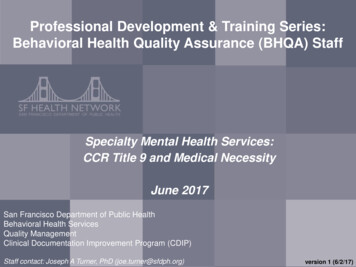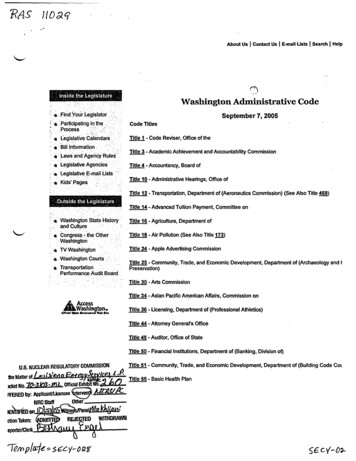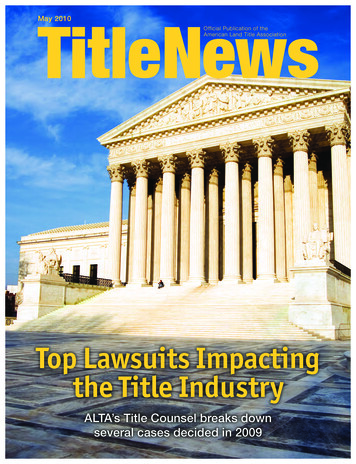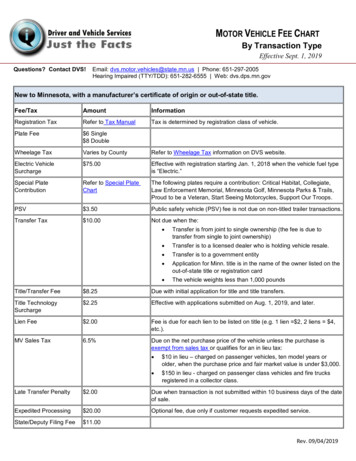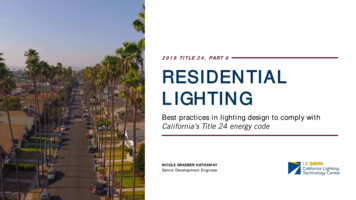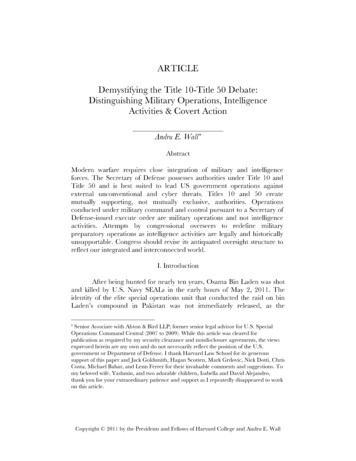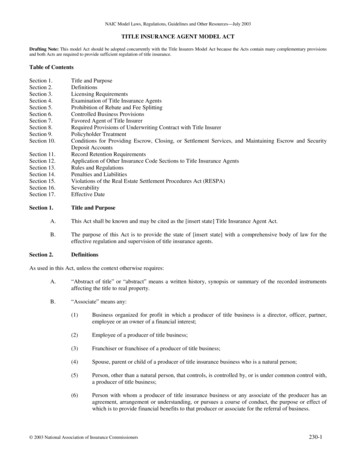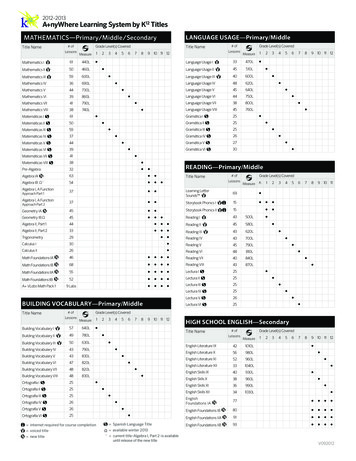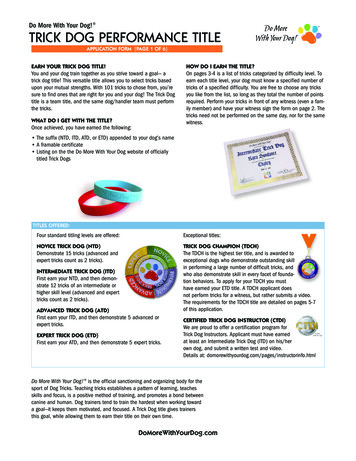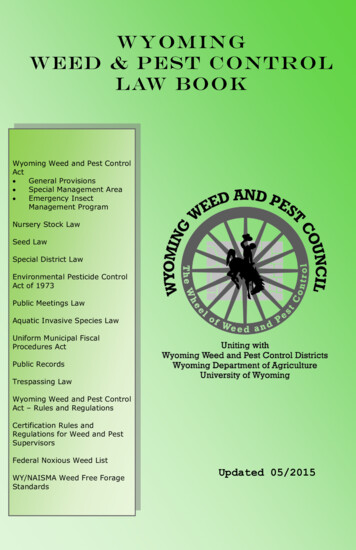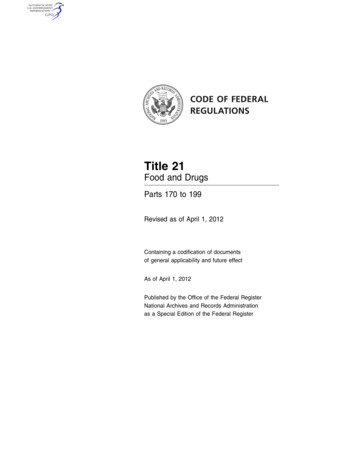
Transcription
Title 21Food and DrugsParts 170 to 199Revised as of April 1, 2012Containing a codification of documentsof general applicability and future effectAs of April 1, 2012erowe on DSK2VPTVN1PROD with CFRPublished by the Office of the Federal RegisterNational Archives and Records Administrationas a Special Edition of the Federal RegisterVerDate Mar 15 201010:14 May 14, 2012Jkt 226069PO 00000Frm 00001Fmt 8091Sfmt 8091Y:\SGML\226069.XXX226069
U.S. GOVERNMENT OFFICIAL EDITION NOTICELegal Status and Use of Seals and LogosThe seal of the National Archives and Records Administration(NARA) authenticates the Code of Federal Regulations (CFR) asthe official codification of Federal regulations established underthe Federal Register Act. Under the provisions of 44 U.S.C. 1507, thecontents of the CFR, a special edition of the Federal Register, shallbe judicially noticed. The CFR is prima facie evidence of the original documents published in the Federal Register (44 U.S.C. 1510).It is prohibited to use NARA’s official seal and the stylized Codeof Federal Regulations logo on any republication of this materialwithout the express, written permission of the Archivist of theUnited States or the Archivist’s designee. Any person usingNARA’s official seals and logos in a manner inconsistent with theprovisions of 36 CFR part 1200 is subject to the penalties specifiedin 18 U.S.C. 506, 701, and 1017.Use of ISBN PrefixThis is the Official U.S. Government edition of this publicationand is herein identified to certify its authenticity. Use of the 0–16ISBN prefix is for U.S. Government Printing Office Official Editions only. The Superintendent of Documents of the U.S. Government Printing Office requests that any reprinted edition clearly belabeled as a copy of the authentic work with a new ISBN.erowe on DSK2VPTVN1PROD with CFRU.S. Superintendent of Documents Washington, DC 20402–0001http://bookstore.gpo.govPhone: toll-free (866) 512-1800; DC area (202) 512-1800VerDate Mar 15 201010:14 May 14, 2012Jkt 226069PO 00000Frm 00002Fmt 8092Sfmt 8092Y:\SGML\226069.XXX226069e:\seals\archives.ai /GPH e:\seals\gpologo.eps /GPH U.S. GOVERNMENT PRINTING OFFICE
Table of ContentsPageExplanation .vTitle 21:Chapter I—Food and Drug Administration, Department of Healthand Human Services (Continued) .3erowe on DSK2VPTVN1PROD with CFRFinding Aids:Table of CFR Titles and Chapters .607Alphabetical List of Agencies Appearing in the CFR .627List of CFR Sections Affected .637iiiVerDate Mar 15 201010:14 May 14, 2012Jkt 226069PO 00000Frm 00003Fmt 8092Sfmt 8092Y:\SGML\226069.XXX226069
Cite this Code:CFRerowe on DSK2VPTVN1PROD with CFRTo cite the regulations inthis volume use title,part and section number. Thus, 21 CFR 170.3refers to title 21, part170, section 3.ivVerDate Mar 15 201010:14 May 14, 2012Jkt 226069PO 00000Frm 00004Fmt 8092Sfmt 8092Y:\SGML\226069.XXX226069
ExplanationThe Code of Federal Regulations is a codification of the general and permanentrules published in the Federal Register by the Executive departments and agencies of the Federal Government. The Code is divided into 50 titles which representbroad areas subject to Federal regulation. Each title is divided into chapterswhich usually bear the name of the issuing agency. Each chapter is further subdivided into parts covering specific regulatory areas.Each volume of the Code is revised at least once each calendar year and issuedon a quarterly basis approximately as follows:Title 1 through Title 16.as of January 1Title 17 through Title 27 .as of April 1Title 28 through Title 41 .as of July 1Title 42 through Title 50 .as of October 1The appropriate revision date is printed on the cover of each volume.LEGAL STATUSThe contents of the Federal Register are required to be judicially noticed (44U.S.C. 1507). The Code of Federal Regulations is prima facie evidence of the textof the original documents (44 U.S.C. 1510).HOW TO USE THE CODE OF FEDERAL REGULATIONSThe Code of Federal Regulations is kept up to date by the individual issuesof the Federal Register. These two publications must be used together to determine the latest version of any given rule.To determine whether a Code volume has been amended since its revision date(in this case, April 1, 2012), consult the ‘‘List of CFR Sections Affected (LSA),’’which is issued monthly, and the ‘‘Cumulative List of Parts Affected,’’ whichappears in the Reader Aids section of the daily Federal Register. These two listswill identify the Federal Register page number of the latest amendment of anygiven rule.EFFECTIVE AND EXPIRATION DATESEach volume of the Code contains amendments published in the Federal Register since the last revision of that volume of the Code. Source citations forthe regulations are referred to by volume number and page number of the FederalRegister and date of publication. Publication dates and effective dates are usually not the same and care must be exercised by the user in determining theactual effective date. In instances where the effective date is beyond the cutoff date for the Code a note has been inserted to reflect the future effectivedate. In those instances where a regulation published in the Federal Registerstates a date certain for expiration, an appropriate note will be inserted followingthe text.erowe on DSK2VPTVN1PROD with CFROMB CONTROL NUMBERSThe Paperwork Reduction Act of 1980 (Pub. L. 96–511) requires Federal agenciesto display an OMB control number with their information collection request.vVerDate Mar 15 201010:14 May 14, 2012Jkt 226069PO 00000Frm 00005Fmt 8008Sfmt 8092Y:\SGML\226069.XXX226069
Many agencies have begun publishing numerous OMB control numbers as amendments to existing regulations in the CFR. These OMB numbers are placed asclose as possible to the applicable recordkeeping or reporting requirements.OBSOLETE PROVISIONSProvisions that become obsolete before the revision date stated on the coverof each volume are not carried. Code users may find the text of provisions ineffect on a given date in the past by using the appropriate numerical list ofsections affected. For the period before January 1, 2001, consult either the Listof CFR Sections Affected, 1949–1963, 1964–1972, 1973–1985, or 1986–2000, publishedin eleven separate volumes. For the period beginning January 1, 2001, a ‘‘Listof CFR Sections Affected’’ is published at the end of each CFR volume.‘‘[RESERVED]’’ TERMINOLOGYThe term ‘‘[Reserved]’’ is used as a place holder within the Code of FederalRegulations. An agency may add regulatory information at a ‘‘[Reserved]’’ location at any time. Occasionally ‘‘[Reserved]’’ is used editorially to indicate thata portion of the CFR was left vacant and not accidentally dropped due to a printing or computer error.INCORPORATION BY REFERENCEWhat is incorporation by reference? Incorporation by reference was establishedby statute and allows Federal agencies to meet the requirement to publish regulations in the Federal Register by referring to materials already published elsewhere. For an incorporation to be valid, the Director of the Federal Registermust approve it. The legal effect of incorporation by reference is that the material is treated as if it were published in full in the Federal Register (5 U.S.C.552(a)). This material, like any other properly issued regulation, has the forceof law.What is a proper incorporation by reference? The Director of the Federal Registerwill approve an incorporation by reference only when the requirements of 1 CFRpart 51 are met. Some of the elements on which approval is based are:(a) The incorporation will substantially reduce the volume of material published in the Federal Register.(b) The matter incorporated is in fact available to the extent necessary toafford fairness and uniformity in the administrative process.(c) The incorporating document is drafted and submitted for publication inaccordance with 1 CFR part 51.What if the material incorporated by reference cannot be found? If you have anyproblem locating or obtaining a copy of material listed as an approved incorporation by reference, please contact the agency that issued the regulation containingthat incorporation. If, after contacting the agency, you find the material is notavailable, please notify the Director of the Federal Register, National Archivesand Records Administration, 8601 Adelphi Road, College Park, MD 20740-6001, orcall 202-741-6010.erowe on DSK2VPTVN1PROD with CFRCFR INDEXES AND TABULAR GUIDESA subject index to the Code of Federal Regulations is contained in a separatevolume, revised annually as of January 1, entitled CFR INDEX AND FINDING AIDS.This volume contains the Parallel Table of Authorities and Rules. A list of CFRtitles, chapters, subchapters, and parts and an alphabetical list of agencies publishing in the CFR are also included in this volume.An index to the text of ‘‘Title 3—The President’’ is carried within that volume.viVerDate Mar 15 201010:14 May 14, 2012Jkt 226069PO 00000Frm 00006Fmt 8008Sfmt 8092Y:\SGML\226069.XXX226069
The Federal Register Index is issued monthly in cumulative form. This indexis based on a consolidation of the ‘‘Contents’’ entries in the daily Federal Register.A List of CFR Sections Affected (LSA) is published monthly, keyed to therevision dates of the 50 CFR titles.REPUBLICATION OF MATERIALThere are no restrictions on the republication of material appearing in theCode of Federal Regulations.INQUIRIESFor a legal interpretation or explanation of any regulation in this volume,contact the issuing agency. The issuing agency’s name appears at the top ofodd-numbered pages.For inquiries concerning CFR reference assistance, call 202–741–6000 or writeto the Director, Office of the Federal Register, National Archives and RecordsAdministration, 8601 Adelphi Road, College Park, MD 20740-6001 or e-mailfedreg.info@nara.gov.SALESThe Government Printing Office (GPO) processes all sales and distribution ofthe CFR. For payment by credit card, call toll-free, 866-512-1800, or DC area, 202512-1800, M-F 8 a.m. to 4 p.m. e.s.t. or fax your order to 202-512-2104, 24 hoursa day. For payment by check, write to: US Government Printing Office – NewOrders, P.O. Box 979050, St. Louis, MO 63197-9000.ELECTRONIC SERVICESThe full text of the Code of Federal Regulations, the LSA (List of CFR SectionsAffected), The United States Government Manual, the Federal Register, PublicLaws, Public Papers of the Presidents of the United States, Compilation of Presidential Documents and the Privacy Act Compilation are available in electronicformat via www.ofr.gov. For more information, contact the GPO Customer Contact Center, U.S. Government Printing Office. Phone 202-512-1800, or 866-512-1800(toll-free). E-mail, gpo@custhelp.com.The Office of the Federal Register also offers a free service on the NationalArchives and Records Administration’s (NARA) World Wide Web site for publiclaw numbers, Federal Register finding aids, and related information. Connectto NARA’s web site at www.archives.gov/federal-register.erowe on DSK2VPTVN1PROD with CFRMICHAEL L. WHITE,Acting Director,Office of the Federal Register.April 1, 2012.viiVerDate Mar 15 201010:14 May 14, 2012Jkt 226069PO 00000Frm 00007Fmt 8008Sfmt 8092Y:\SGML\226069.XXX226069
erowe on DSK2VPTVN1PROD with CFRVerDate Mar 15 201010:14 May 14, 2012Jkt 226069PO 00000Frm 00008Fmt 8008Sfmt 8092Y:\SGML\226069.XXX226069
THIS TITLETitle 21—FOOD AND DRUGS is composed of nine volumes. The parts in thesevolumes are arranged in the following order: Parts 1–99, 100–169, 170–199, 200–299,300–499, 500–599, 600–799, 800–1299 and 1300 to end. The first eight volumes, containing parts 1–1299, comprise Chapter I—Food and Drug Administration, Department of Health and Human Services. The ninth volume, containing part 1300 toend, includes Chapter II—Drug Enforcement Administration, Department of Justice, and Chapter III—Office of National Drug Control Policy. The contents ofthese volumes represent all current regulations codified under this title of theCFR as of April 1, 2012.erowe on DSK2VPTVN1PROD with CFRFor this volume, Susannah C. Hurley was Chief Editor. The Code of FederalRegulations publication program is under the direction of Michael L. White, assisted by Ann Worley.ixVerDate Mar 15 201010:14 May 14, 2012Jkt 226069PO 00000Frm 00009Fmt 8092Sfmt 8092Y:\SGML\226069.XXX226069
erowe on DSK2VPTVN1PROD with CFRVerDate Mar 15 201010:14 May 14, 2012Jkt 226069PO 00000Frm 00010Fmt 8092Sfmt 8092Y:\SGML\226069.XXX226069
Title 21—Food andDrugs(This book contains parts 170 to 199)Partand Drug Administration, Department ofHealth and Human Services (Continued) .erowe on DSK2VPTVN1PROD with CFRCHAPTER I—Food1VerDate Mar 15 201010:14 May 14, 2012Jkt 226069PO 00000Frm 00011Fmt 8008Sfmt 8008Y:\SGML\226069.XXX226069170
erowe on DSK2VPTVN1PROD with CFRVerDate Mar 15 201010:14 May 14, 2012Jkt 226069PO 00000Frm 00012Fmt 8008Sfmt 8008Y:\SGML\226069.XXX226069
CHAPTER I—FOOD AND DRUGADMINISTRATION, DEPARTMENT OF HEALTHAND HUMAN SERVICES (CONTINUED)(Parts 170 to 199)EDITORIAL NOTE: Nomenclature changes to chapter I appear at 59 FR 14366, Mar. 28, 1994,and 69 FR 18803, Apr. 9, 2004.SUBCHAPTER B—FOOD FOR HUMAN CONSUMPTION 1182184erowe on DSK2VPTVN1PROD with CFR186189190PageFood additives .Food additive petitions .Food additives permitted for direct addition tofood for human consumption .Secondary direct food additives permitted in foodfor human consumption .Indirect food additives: General .Indirect food additives: Adhesives and componentsof coatings .Indirect food additives: Paper and paperboard components .Indirect food additives: Polymers .Indirect food additives: Adjuvants, productionaids, and sanitizers .Irradiation in the production, processing and handling of food .Food additives permitted in food or in contactwith food on an interim basis pending additionalstudy .Prior-sanctioned food ingredients .Substances generally recognized as safe .Direct food substances affirmed as generally recognized as safe .Indirect food substances affirmed as generally recognized as safe .Substances prohibited from use in human food .Dietary supplements .3VerDate Mar 15 201010:14 May 14, 2012Jkt 226069PO 00000Frm 00013Fmt 8008Sfmt 2456462467472485590595602
21 CFR Ch. I (4–1–12 Edition)PartPageerowe on DSK2VPTVN1PROD with CFR191–199[Reserved]4VerDate Mar 15 201010:14 May 14, 2012Jkt 226069PO 00000Frm 00014Fmt 8008Sfmt 8008Y:\SGML\226069.XXX226069
SUBCHAPTER B—FOOD FOR HUMAN CONSUMPTION(CONTINUED)PART 170—FOOD ADDITIVES170.106 Notification for a food contact substance formulation (NFCSF).Subpart A—General ProvisionsAUTHORITY: 21 U.S.C. 321, 341, 342, 346a, 348,371.Sec.170.3 Definitions.170.6 Opinion letters on food additive status.170.10 Food additives in standardized foods.170.15 Adoption of regulation on initiativeof Commissioner.170.17 Exemption for investigational useand procedure for obtaining authorization to market edible products from experimental animals.170.18 Tolerances for related food additives.170.19 Pesticide chemicals in processedfoods.SOURCE: 42 FR 14483, Mar. 15, 1977, unlessotherwise noted.EDITORIAL NOTE: Nomenclature changes topart 170 appear at 66 FR 56035, Nov. 6, 2001and 69 FR 13717, Mar. 24, 2004.Subpart A—General Provisions§ 170.3 Definitions.For the purposes of this subchapter,the following definitions apply:(a) Secretary means the Secretary ofHealth and Human Services.(b) Department means the Departmentof Health and Human Services.(c) Commissioner means the Commissioner of Food and Drugs.(d) As used in this part, the term actmeans the Federal Food, Drug, andCosmetic Act approved June 25, 1936, 52Stat. 1040 et seq., as amended (21 U.S.C.301–392).(e)(1) Food additives includes all substances not exempted by section 201(s)of the act, the intended use of whichresults or may reasonably be expectedto result, directly or indirectly, eitherin their becoming a component of foodor otherwise affecting the characteristics of food. A material used in the production of containers and packages issubject to the definition if it may reasonably be expected to become a component, or to affect the characteristics,directly or indirectly, of food packed inthe container. ‘‘Affecting the characteristics of food’’ does not include suchphysical effects, as protecting contentsof packages, preserving shape, and preventing moisture loss. If there is nomigration of a packaging componentfrom the package to the food, it doesnot become a component of the foodand thus is not a food additive. A substance that does not become a component of food, but that is used, for example, in preparing an ingredient of thefood to give a different flavor, texture,or other characteristic in the food,may be a food additive.Subpart B—Food Additive Safety170.20 General principles for evaluating thesafety of food additives.170.22 Safety factors to be considered.170.30 Eligibility for classification as generally recognized as safe (GRAS).170.35 Affirmation of generally recognizedas safe (GRAS) status.170.38 Determination of food additive status.170.39 Threshold of regulation for substances used in food-contact articles.Subpart C—Specific Administrative Rulingsand Decisions170.45 Fluorine-containing compounds.170.50 Glycine (aminoacetic acid) in food forhuman consumption.170.60 Nitrites and/or nitrates in curing premixes.erowe on DSK2VPTVN1PROD with CFRSubpart D—Premarket Notifications170.100 Submission of a premarket notification for a food contact substance (FCN)to the Food and Drug Administration(FDA).170.101 Information in a premarket notification for a food contact substance (FCN).170.102 Confidentiality of information in apremarket notification for a food contactsubstance (FCN).170.103 Withdrawal without prejudice of apremarket notification for a food contactsubstance (FCN).170.104 Action on a premarket notificationfor a food contact substance (FCN).170.105 The Food and Drug Administration’s(FDA’s) determination that a premarketnotification for a food contact substance(FCN) is no longer effective.5VerDate Mar 15 201010:14 May 14, 2012Jkt 226069PO 00000Frm 00015Fmt 8010Sfmt 8010Y:\SGML\226069.XXX226069
erowe on DSK2VPTVN1PROD with CFR§ 170.321 CFR Ch. I (4–1–12 Edition)(2) Uses of food additives not requiringa listing regulation. Use of a substancein a food contact article (e.g., foodpackaging or food-processing equipment) whereby the substance migrates,or may reasonably be expected to migrate, into food at such levels that theuse has been exempted from regulationas a food additive under § 170.39, andfood contact substances used in accordance with a notification submittedunder section 409(h) of the act that iseffective.(3) A food contact substance is any substance that is intended for use as acomponent of materials used in manufacturing, packing, packaging, transporting, or holding food if such use isnot intended to have any technical effect in such food.(f) Common use in food means a substantial history of consumption of asubstance for food use by a significantnumber of consumers.(g) The word substance in the definition of the term ‘‘food additive’’ includes a food or food component consisting of one or more ingredients.(h) Scientific procedures include thosehuman, animal, analytical, and otherscientific studies, whether published orunpublished, appropriate to establishthe safety of a substance.(i) Safe or safety means that there isa reasonable certainty in the minds ofcompetent scientists that the substance is not harmful under the intended conditions of use. It is impossible in the present state of scientificknowledge to establish with completecertainty the absolute harmlessness ofthe use of any substance. Safety maybe determined by scientific proceduresor by general recognition of safety. Indetermining safety, the following factors shall be considered:(1) The probable consumption of thesubstance and of any substance formedin or on food because of its use.(2) The cumulative effect of the substance in the diet, taking into accountany chemically or pharmacologicallyrelated substance or substances in suchdiet.(3) Safety factors which, in the opinion of experts qualified by scientifictraining and experience to evaluate thesafety of food and food ingredients, aregenerally recognized as appropriate.(j) The term nonperishable processedfood means any processed food not subject to rapid decay or deteriorationthat would render it unfit for consumption. Examples are flour, sugar, cereals, packaged cookies, and crackers.Not included are hermetically sealedfoods or manufactured dairy productsand other processed foods requiring refrigeration.(k) General recognition of safety shallbe determined in accordance with§ 170.30.(l) Prior sanction means an explicitapproval granted with respect to use ofa substance in food prior to September6, 1958, by the Food and Drug Administration or the United States Department of Agriculture pursuant to theFederal Food, Drug, and Cosmetic Act,the Poultry Products Inspection Act,or the Meat Inspection Act.(m) Food includes human food, substances migrating to food from foodcontact articles, pet food, and animalfeed.(n) The following general food categories are established to group specific related foods together for the purpose of establishing tolerances or limitations for the use of direct humanfood ingredients. Individual food products will be included within these categories according to the detailed classifications lists contained in Exhibit33B of the report of the National Academy of Sciences/National ResearchCouncil report, ‘‘A Comprehensive Survey of Industry on the Use of FoodChemicals Generally Recognized asSafe’’ (September 1972), which is incorporated by reference. Copies are available from the National Technical Information Service (NTIS), 5285 Port RoyalRd., Springfield, VA 22161, or at the National Archives and Records Administration (NARA). For information onthe availability of this material atNARA, call 202–741–6030, or go to: ederallregulations/ibrllocations.html.(1) Baked goods and baking mixes, including all ready-to-eat and ready-tobake products, flours, and mixes requiring preparation before serving.(2) Beverages, alcoholic, includingmalt beverages, wines, distilled liquors, and cocktail mix.6VerDate Mar 15 201010:14 May 14, 2012Jkt 226069PO 00000Frm 00016Fmt 8010Sfmt 8010Y:\SGML\226069.XXX226069
erowe on DSK2VPTVN1PROD with CFRFood and Drug Administration, HHS§ 170.3(3) Beverages and beverage bases,nonalcoholic, including only special orspiced teas, soft drinks, coffee substitutes, and fruit and vegetable flavored gelatin drinks.(4)Breakfastcereals,includingready-to-eat and instant and regularhot cereals.(5) Cheeses, including curd and wheycheeses, cream, natural, grating, processed, spread, dip, and miscellaneouscheeses.(6) Chewing gum, including all forms.(7) Coffee and tea, including regular,decaffeinated, and instant types.(8) Condiments and relishes, including plain seasoning sauces and spreads,olives, pickles, and relishes, but notspices or herbs.(9) Confections and frostings, including candy and flavored frostings,marshmallows, baking chocolate, andbrown, lump, rock, maple, powdered,and raw sugars.(10) Dairy product analogs, includingnondairy milk, frozen or liquid creamers, coffee whiteners, toppings, andother nondairy products.(11) Egg products, including liquid,frozen, or dried eggs, and egg dishesmade therefrom, i.e., egg roll, egg fooyoung, egg salad, and frozen multicourse egg meals, but not fresh eggs.(12) Fats and oils, including margarine, dressings for salads, butter,salad oils, shortenings and cookingoils.(13) Fish products, including all prepared main dishes, salads, appetizers,frozen multicourse meals, and spreadscontaining fish, shellfish, and otheraquatic animals, but not fresh fish.(14) Fresh eggs, including cookedeggs and egg dishes made only fromfresh shell eggs.(15) Fresh fish, including only freshand frozen fish, shellfish, and otheraquatic animals.(16) Fresh fruits and fruit juices, including only raw fruits, citrus, melons,and berries, and home-prepared ‘‘ades’’and punches made therefrom.(17) Fresh meats, including only freshor home-frozen beef or veal, pork, lambor mutton and home-prepared freshmeat-containing dishes, salads, appetizers, or sandwich spreads made therefrom.(18) Fresh poultry, including onlyfresh or home-frozen poultry and gamebirds and home-prepared fresh poultrycontaining dishes, salads, appetizers, orsandwich spreads made therefrom.(19) Fresh vegetables, tomatoes, andpotatoes, including only fresh andhome-prepared vegetables.(20) Frozen dairy desserts and mixes,including ice cream, ice milks, sherbets, and other frozen dairy dessertsand specialties.(21) Fruit and water ices, includingall frozen fruit and water ices.(22) Gelatins, puddings, and fillings,including flavored gelatin desserts,puddings, custards, parfaits, pie fillings, and gelatin base salads.(23) Grain products and pastas, including macaroni and noodle products,rice dishes, and frozen multicoursemeals, without meat or vegetables.(24) Gravies and sauces, including allmeat sauces and gravies, and tomato,milk, buttery, and specialty sauces.(25) Hard candy and cough drops, including all hard type candies.(26) Herbs, seeds, spices, seasonings,blends, extracts, and flavorings, including all natural and artificial spices,blends, and flavors.(27) Jams and jellies, home-prepared,including only home-prepared jams,jellies, fruit butters, preserves, andsweet spreads.(28) Jams and jellies, commercial, including only commercially processedjams, jellies, fruit butters, preserves,and sweet spreads.(29) Meat products, including allmeats and meat containing dishes, salads, appetizers, frozen multicoursemeat meals, and sandwich ingredientsprepared by commercial processing orusing commercially processed meatswith home preparation.(30) Milk, whole and skim, includingonly whole, lowfat, and skim fluidmilks.(31) Milk products, including flavoredmilks and milk drinks, dry milks, toppings, snack dips, spreads, weight control milk beverages, and other milk origin products.(32) Nuts and nut products, includingwhole or shelled tree nuts, peanuts, coconut, and nut and peanut spreads.7VerDate Mar 15 201010:14 May 14, 2012Jkt 226069PO 00000Frm 00017Fmt 8010Sfmt 8010Y:\SGML\226069.XXX226069
erowe on DSK2VPTVN1PROD with CFR§ 170.321 CFR Ch. I (4–1–12 Edition)(33) Plant protein products, includingthe National Academy of Sciences/National Research Council ‘‘reconstitutedvegetable protein’’ category, and meat,poultry, and fish substitutes, analogs,and extender products made from plantproteins.(34) Poultry products, including allpoultry and poultry-containing dishes,salads, appetizers, frozen multicoursepoultry meals, and sandwich ingredients prepared by commercial processing or using commercially processedpoultry with home preparation.(35) Processed fruits and fruit juices,including all commercially processedfruits, citrus, berries, and mixtures;salads, juices and juice punches, concentrates, dilutions, ‘‘ades’’, and drinksubstitutes made therefrom.(36) Processed vegetables and vegetable juices, including all commercially processed vegetables, vegetabledishes, frozen multicourse vegetablemeals, and vegetable juices and blends.(37) Snack foods, including chips,pretzels, and other novelty snacks.(38) Soft candy, including candy bars,chocolates, fudge, mints, and otherchewy or nougat candies.(39) Soups, home-prepared, includingmeat, fish, poultry, vegetable, andcombination home-prepared soups.(40) Soups and soup mixes, includingcommercially prepared meat, fish,poultry, vegetable, and combinationsoups and soup mixes.(41) Sugar, white, granulated, including only white granulated sugar.(42) Sugar substitutes, includinggranulated, liquid, and tablet sugarsubstitutes.(43) Sweet sauces, toppings, and syrups, including chocolate, berry, fruit,corn syrup, and maple sweet sauces andtoppings.(o) The following terms describe thephysical or technical functional effectsfor which direct human food ingredients may be added to foods. They areadopted from the National Academy ofSciences/National Research Council national survey of food industries, reported to the Food and Drug Administration under the contract title ‘‘AComprehensive Survey of Industry onthe Use of Food Chemicals GenerallyRecognized as Safe’’ (September 1972),which is incorporated by reference.Copies are available from the NationalTechnical Information Service (NTIS),5285 Port Royal Rd., Springfield, VA22161, or at the National Archives andReco
Cite this Code: CFR To cite the regulations in this volume use title, part and section num-ber. Thus, 21 CFR 170.3 refers to title 21, part 170, section 3. erowe on DSK2VPTVN1PROD with CFR VerDate Mar 15 2010 10:14 May 14, 2012 Jkt 226069 PO 00000 Frm 00004 Fmt 8092 Sfmt 8092 Y:\SGML\226069.XXX 226069
